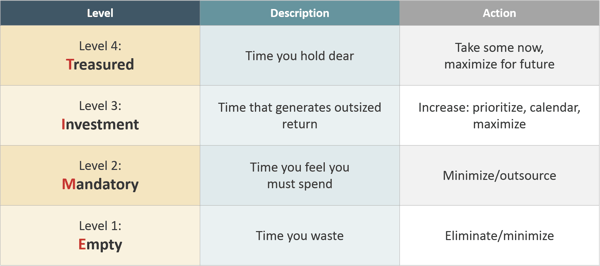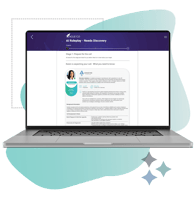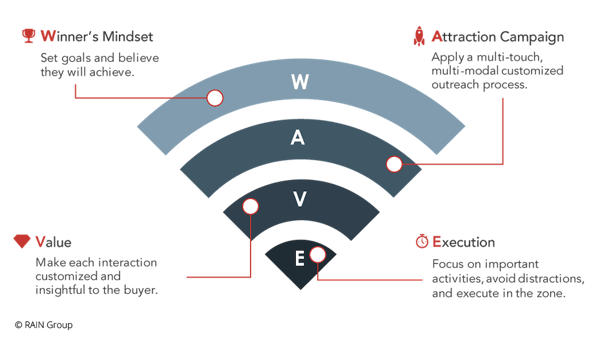Unless you’ve been on an extended media break, you’re aware that artificial Intelligence (AI) is making a splash across all industries of business.
I’ve seen this as a practitioner. I work closely with client organizations and collaborate with senior executives, and I’ve been getting a lot of questions lately about AI. What’s RAIN Group’s position on AI? What’s working for sales teams in terms of applying AI? How do we make AI work for us?
Sales organizations are trying to figure out which AI tools and technologies, if any, they should be embracing. While there seems to be a high level of interest and curiosity, based on our recent research, most sales teams have yet to adopt AI-related tools into their sales process. This could prove a big missed opportunity since the research also revealed that AI can make a significant impact, at least for those who use the tools frequently.
One area in sales organizations that especially lends itself to benefitting from AI is prospecting. For B2B sellers, finding and connecting with potential buyers is tough. Success for sales organizations today takes more than having the right sellers with the right skills. Success at scale means using smart, modern methods to gain an advantage with a notoriously challenging activity.
This is where AI comes in.
In this article, we'll examine how to use AI as part of a sales prospecting strategy, helping sellers overcome common challenges and achieve goals. We’ll focus on the use of chatbots like ChatGPT and Copilot (formerly Bing Chat) in sales prospecting.
 (no form required) to take these prompt recommendations with you.
(no form required) to take these prompt recommendations with you.
Getting Started with AI in Sales Prospecting
The Power of AI in Prospecting
AI has emerged as a game-changer in sales organizations, especially when it comes to prospecting. AI's ability to analyze vast amounts of data and uncover patterns offers sales teams unprecedented insights into their target markets. This technology empowers sellers by automating time-consuming tasks, providing predictive analytics, and personalizing customer interactions.
As AI continues to improve seemingly daily, its integration into sales prospecting has given some sellers an edge. A variety of technologies and integrations are available, including large language models (LLMs) like ChatGPT, integrations to improve productivity and efficiency, and CRM integrations like Einstein in Salesforce and Microsoft Sales Copilot.
Embracing AI tools can help sales teams stay ahead of the curve, identifying and engaging with potential buyers more efficiently and effectively than ever before.
Developing a Winner's Mindset
First, let’s acknowledge that prospecting is not a universally loved sales activity. Only 49% of respondents in our research on Top Performance in Sales Prospecting report they enjoy it.
But, interestingly, 73% of Top Performers do enjoy prospecting and get better results—a case of mindset influencing results.
We call it “winner’s mindset,” and it applies to the adoption of AI, as well as to sales prospecting and other sales activities. When it comes to AI, it means being open to trying new technologies, identifying the benefits of AI, and gathering inspiration from AI.
Embracing AI in sales prospecting involves recognizing its potential to streamline tasks and enhance decision-making.
For instance, AI can swiftly analyze customer data, identifying key trends and patterns that would take humans much longer to uncover. This capability not only saves time but also provides deeper insights for crafting more effective sales messages. In addition, AI-powered tools can prioritize leads based on their likelihood to convert, allowing sales teams to focus their efforts more effectively.
How can you identify specific benefits of using AI in prospecting? Go to the chatbot and ask. For example:
I'm seller of <insert solution> looking to improve my success with reaching out and setting meetings with new prospects in <industry>. How can ChatGPT help me improve my prospecting efforts?
If you’re feeling less than motivated to begin your prospecting activities, you can ask:
I'm a seller having a tough time getting through to my prospects. Can you offer some encouragement and an inspirational quote?
Keep Two Themes in Mind to Make the Most of AI
Here are two ways you’re going to impact your mindset and make the most of AI in sales prospecting.
1. Minimize Mandatory Time and Increase Investment Time
As we detail in the 4 Levels of TIME framework shared in our productivity training, 9 Habits of Extreme Productivity, everything you do in work and life falls into one of these categories.

For the greatest productivity, performance, job satisfaction, and happiness you want to minimize Mandatory time and increase Investment time.
AI is the first tool I've seen that can transform the way we work to allow the workforce to actually do this at scale.
AI:
- Can improve your productivity and create faster and higher-quality work output
- Allows you to spend time doing what’s most effective, thereby increasing value
- Becomes part of a winning combo when paired with the human element; it releases the mental load and improves your capacity
Think about what’s possible if you can apply all that additional capacity to provide more value for your clients and prospects. It’s a powerful concept.
2. View AI as a Teammate
Think of AI as a new colleague. Someone you can collaborate with, to bounce ideas off of, to do research for you, and to summarize meetings and notes for you.
Keep in mind, though, that while it’s like working with a human, it’s not a human. It’s not always accurate, just like working with a colleague who might not always be accurate. You always need to validate the work on your own. Think of AI as ancillary; it does not replace the human factor.
How Do AI Advocates Use It?
Respondents reporting the greatest impact on sales performance and productivity from AI
are significantly more likely to strongly agree:

Respondents in our research who report the greatest impact on sales performance from AI are significantly more likely to see AI as a benefit in the following ways:
- As a teammate to collaborate with
- To help uncover buyer challenges and pain points
- To reduce the time spent doing manual tasks
- To allow time to focus on higher-value tasks
By understanding the benefits (and cautions) and adopting a positive mindset towards AI, you can leverage this technology to optimize your prospecting efforts, leading to a more successful and efficient approach.
Put AI to Work Filling the Pipeline
In our work with clients, we coach them on executing the WAVE Method to fill their pipelines. This framework enables sellers to create quality conversations and to be as valuable as possible to their buyers, making the most of their sales opportunities.
These are the elements of the framework:
- Winner’s Mindset: Top performers adopt a winner’s mindset by setting goals and reaching those goals.
- Attraction Campaign: You need to apply a multi-touch, multi-modal, customized outreach process designed to generate meetings with buyers through ongoing one-to-one effort.
- Value: Make each interaction customized and insightful to the buyer. Why should a buyer meet with you?
- Execution: Top performers focus on important activities, avoid distractions, and execute in the zone and with strong prospecting skills.
Winner’s Mindset was covered earlier. Next, let’s go through the remaining areas of the framework: Attraction Campaign, Value, and Execution.
Build an Attraction Campaign
An attraction campaign is the outreach plan you’ll use to fill your pipeline.
Components of an Attraction Campaign

There are five components to an attraction campaign: strategy, targeting, offer, outreach, and conversion. AI can help with each one. Here are a few examples of where and how you can use AI to build the plan.
We'll focus on the targeting, offer, and outreach steps here. Using AI tools assists with strategy and conversion by helping you plan, execute, and iterate on the other three steps. Once you've engaged with a prospect, the information they provide can inform prompts on how to respond to objections, secure a conversion, and move a prospect along the sales funnel. For strategy, AI can also help you generate background research and insights to inform your prospecting. See below for more on this.
Targeting: Who You Want to Meet With
In terms of targeting—identifying who you want to generate meetings with—you can use a chatbot to help you outline a target profile, build buyer personas, build a list of names and targets, and analyze and segment target lists.
Sample prompts for you to give a chatbot include:
I work in sales. Our top clients include <insert names>. Based on this, write an ideal client profile that includes <insert criteria such as company size, industry, common pain points, location, etc.>.
I sell <insert solution> to these companies. Typical buyers include <insert titles>. What are their common pain points?
I'm building a buyer persona for <insert title>. I sell <insert brief description>. What are the top 5 challenges these buyers face?
If your prompts based on a company’s name aren’t giving you the results you want, try elaborating on what the company does, how they do it, their industry, and so on.
Offer: What Prospects Will Find Compelling
AI can be exceptionally useful in uncovering insights you can bring to your prospects in the form of a value-based offer. You can very quickly research your prospects’ industries, uncover common pain points, and gather CRM data. If you’re using tools like Einstein in SFDC, you can conduct company research. This allows you to provide highly personalized outreach and relevant offers faster than ever before.
However, it’s important to know the limitations of the tools you’re using. For example, use a tool connected to the internet, such as Copilot, to access current information instead of a chatbot that's been trained on a dated data set.
Outreach: How You’ll Break Through
Our Top Performance in Sales Prospecting research found that buyers prefer to be contacted using the following outreach channels:
- Phone
- Networking and social media
- Direct mail
Warm-up emails, a phone call, a LinkedIn request, maybe something sent by snail mail, plus comments on social media posts over time, and maybe even a video or two—it can make all the difference. But don’t do this all at once.
Remember: an attraction campaign is executed over time. Plan your touch sequence in advance. If you have to think every day, “What am I going to send or say to people today?”, you’ll never get in a rhythm, and you’ll always be fighting to figure out what to do.
With a smart, coordinated attraction campaign, you’ll have your communications queued up so you can execute more efficiently to regularly add new opportunities to your pipeline.
You can use chatbots to help you craft a customized outreach sequence. To follow on from the targeting example above, you can continue the chatbot conversation. Prime it to focus on the challenges and pain points and build on what’s already been done. For example:
Keep in mind the buyers from above and their pain points, industry, title, and challenges from above.
Now imagine you're a seller trying to get through to these tough to reach buyers. Craft an outreach sequence that takes place over <timeframe> that includes at least <X number of touches> via <medium: email, LinkedIn outreach, phone calls, etc.>.
Key to breaking through the noise is tailoring the research and insights you’ve uncovered in your chatbot conversations to make outreach messages relevant to a prospective buyer. For example, with prompts like the ones below, you can use AI to help you draft and refine your message.
In the outreach messages, touch upon and address these top challenges: <insert from previous chat response>.
In the above email, reference <insert point> from <insert company>'s annual report and tie it to our solution of <insert your solution>.
In the outreach messages, reference <any interaction you've had, a referral, priorities, work you've done with a similar company, etc.>.
But don’t forget the human element. Be sure to scrutinize and review the output you get from any AI tool.
Ask yourself, does my outreach:
- Offer value based on my prospect’s specific needs?
- Focus on the buyer, not me?
- Address my buyer’s unique objectives or needs, e.g., individual, company, or industry?
- Include social proof of how I've helped others?
Always review:
- Tone of messages: You can prompt chatbots to make a specific email more conversational, formal, technical, professional, and so on. Experiment with the tone and see which sounds most like you.
- Accuracy: It’s your responsibility to validate the accuracy of all information provided in the email.
- Brand compliance: It’s your responsibility to ensure messages comply with your brand standards.
- Authenticity: Does it sound like you? Read it aloud and change any wording that doesn’t work. Make the punctuation consistent with what you typically do, e.g., adding or removing exclamation marks!
- Personalization: Take a moment to personalize the message based on your knowledge, e.g., "How was your daughter’s field hockey game last weekend?" Or, "I see we both know Sally Smith at Eagle Co."
Download the ebook 4 Steps to Fill Your Pipeline with Quality Opportunities, which includes an Attraction Campaign Brief to organize your campaign and messaging.
How to Use AI to Provide Value to Buyers
Because you’ve already done research with AI’s assistance, you’re going to have better background research on prospects from the outset—their industries, challenges, and pain points as they relate to your solution.
Next, you're going to collaborate with the chatbot to brainstorm value-based offers based on these and then use it to help you outline and build out the content for the offer, e.g., white paper, report, article, presentation.
What are the top 5 ways companies can approach <insert industry trend/pain point>?
Write me a business case for why a <insert buyer title> at <insert company name> would be interested in <insert your solution> right now?
I'm trying to break through to a <insert buyer title> at a <insert industry> and persuade them to meet with me to discuss <insert your solution>. What can I offer of value to get them to meet with me?
Why would <insert title> in the <insert industry> be interested in <insert your solution>?
Prompts such as the examples above can give you lots of ideas for value-based offers. In essence, you’re collaborating with the chatbot like a human. Getting ideas, brainstorming, validating what you’re hearing and seeing in the market, and what’s relevant to your business and what’s not.
For more specific insights, you can use a chatbot like Copilot that’s connected to the Internet.
Summarize <insert company> annual report.
Find and summarize <insert company>'s strategic priorities.
Summarize the key points on this web page <insert URL> and turn it into a persuasive email that solves <insert challenge>.
Summarize recent trends at <insert company> and highlight anything related to <insert your solution>.
How can <insert your solution> help <insert company> achieve these priorities?
Execute on Your Plan
The final step in the WAVE method for sales prospecting is Execution and, unfortunately, this is where things tend to fall apart for many sellers. To make sure this doesn’t happen to you, stay focused and disciplined in your prospecting.
Remember the productivity themes introduced earlier: minimize Mandatory time and increase Investment time, and view AI as a teammate.
Examples of how AI can help minimize Mandatory time and how you can use AI as a teammate include having AI help you with research, persuasive writing, sequence creation, editing, and refining messaging. It can help you increase your investment time through hyper-personalization, increased volume of activity, objection handling, and improved execution.
Ideas for How AI Can Help Improve Execution
- Test and refine email subject lines
- Write persuasive and personalized emails
- Conduct research
- Write follow-up templates
- Write responses to emails
- Develop calling scripts
- Practice objections
- Summarize meetings
- Follow up with FAQs
Here are some examples of chatbot prompts you can use to improve your execution:
Create a follow-up email I can use after an initial phone call with a <insert title> who is a potential customer in the <insert industry> interested in <insert solution>. Keep the message to 200 words or fewer and include bullet points.
What objections might the prospect have to meeting with me about this <insert offer and target>?
Create a follow-up email reminding a prospecting about the report <insert title>. Use a conversational tone.
Write a series of 5 social messages addressing <insert target challenges> and how <insert your solution> helps.
When you use AI tools effectively, they can help you maximize your time, energy, and focus available for executing on your prospecting strategy.
Guidelines for Using AI
AI-related tools and technologies can absolutely help sales teams get better at finding and connecting with prospects, but both the tools and the environment are changing daily.
Our recommendation is to explore and experiment with AI, keeping these cautions in mind:
- Validate accuracy
- Do not share proprietary content or customer information
- Understand your organization’s rules and regulations
- Respect copyright and fair use, especially in content generation
- Be aware of biases
- View AI as a tool, not a replacement for human effort
- Incorporate personalization into messages for authenticity
- Be aware AI is rapidly changing
We fully expect that our guidance on using AI in sales prospecting will evolve as the tools evolve. However, by keeping the WAVE method for sales prospecting top-of-mind, you’ll have a framework that remains consistent even as the tools change.










